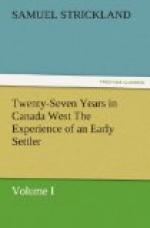Fall-wheat should be sown between the first and fifteenth day of September.* The sooner the better, in my opinion, because the plant is stronger and better able to withstand the frost, and is decidedly less liable to rust. Our fallow having been prepared in this manner, and sown broad-cast with fall-wheat, the next object was to fence in the field securely, which is done in the following way. Trees of a straight growth and straight also in the grain are selected and cut into twelve feet lengths, and are then, by the means of a beetle and wedges, split into rails as nearly four inches square as possible. The rails are then laid in a zigzag direction, crossing each other about a foot from the end, making an angle of about six feet. Seven rails in height, crowned by a stake and rider, complete the fence. The best timbers for making rails, are pine, cedar, oak and black and white ash: these kinds of timbers will last about thirty years. Bass-wood is more commonly used for the first fences, because it is to be procured in greater abundance, and splits more easily; but as it will not last more than ten years, I would not recommend settlers to use it, if the other sorts can readily be obtained.
[* “Fall” is the term usually applied to wheat sown in the autumn by the Canadian farmer, and will be used in this sense throughout a work especially written for the service of the inexperienced settler.]
In this country, hay-cutting commences about the first or second week in July. Timothy-grass and clover mixed or timothy alone are the best for hay, and the most productive. The quantity of seed required for new land is six quarts of grass-seed and two pounds of clover to the acre; on old cleared farms nearly double this seed is required. Timothy is a solid grass with a bulbous root. If the weather is hot and dry, the hay should be carted the second day after cutting, for there is no danger in carting it at once into your barn, the climate being so dry that it never heats enough to cause spontaneous combustion. We have other sorts of grasses, such as red-top, blue-joint, &c.: these grasses, however, are inferior, and therefore never grown from choice.
Soon after my arrival at Darlington, one of my neighbours residing on the lake-shore invited me to a mowing and cradling “Bee."* As I had never seen anything of the kind, I accepted the invitation. On my arrival at the farm on the appointed day, I found assembled about forty men and boys. A man with a pail of spring water with a wooden cup floating on the surface in one hand, and a bottle of whiskey and glass in the other, now approached the swarm, every one helping himself as he pleased. This man is the most important personage at the “Bee,” and is known by the appellation of the “Grog-bos.” On this occasion his office was anything but a sinecure. The heat of the weather, I suppose, had made our party very thirsty. There were thirty-five bees cutting hay, among whom I was a rather awkward volunteer, and ten cradlers** employed in cutting rye.




